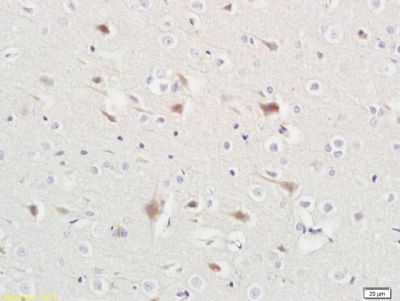ABHD5 Polyclonal Antibody
Purified Rabbit Polyclonal Antibody (Pab)
- SPECIFICATION
- CITATIONS
- PROTOCOLS
- BACKGROUND

Application
| IHC-P, IHC-F, IF, E |
|---|---|
| Primary Accession | Q8WTS1 |
| Reactivity | Rat, Dog, Bovine |
| Host | Rabbit |
| Clonality | Polyclonal |
| Calculated MW | 39 KDa |
| Physical State | Liquid |
| Immunogen | KLH conjugated synthetic peptide derived from human ADHD5 |
| Epitope Specificity | 281-349/349 |
| Isotype | IgG |
| Purity | affinity purified by Protein A |
| Buffer | 0.01M TBS (pH7.4) with 1% BSA, 0.02% Proclin300 and 50% Glycerol. |
| SUBCELLULAR LOCATION | Cytoplasm. Lipid droplet. |
| SIMILARITY | Belongs to the peptidase S33 family. ABHD4/ABHD5 subfamily. |
| SUBUNIT | Interacts with ADRP, PLIN and PNPLA2 (By similarity). |
| DISEASE | Defects in ABHD5 are the cause of Chanarin-Dorfman syndrome (CDS) [MIM:275630]; also called triglyceride storage disease with impaired long-chain fatty acid oxidation or neutral lipid storage disease with ichthyosis. CDS is an autosomal recessive inborn error of lipid metabolism with multisystemic accumulation of triglycerides although plasma concentrations are normal. Clinical characteristics are congenital generalized ichthyosis, vacuolated leukocytes, hepatomegaly, myopathy, cataracts, neurosensory hearing loss and developmental delay. The disorder presents at birth with generalized, fine, white scaling of the skin and a variable degree of erythema resembling non-bullous congenital ichthyosiform erythroderma. |
| Important Note | This product as supplied is intended for research use only, not for use in human, therapeutic or diagnostic applications. |
| Background Descriptions | Abhd5 belongs to a large family of proteins defined by an alpha/beta hydrolase fold, and contains three sequence motifs that correspond to a catalytic triad found in the esterase/lipase/thioesterase subfamily. It differs from other members of this subfamily in that its putative catalytic triad contains an asparagine instead of the serine residue. Mutations in this gene have been associated with Chanarin-Dorfman syndrome, a triglyceride storage disease with impaired long-chain fatty acid oxidation. Widely expressed in various tissues, including skin, lymphocytes, liver, skeletal muscle and brain. |
| Gene ID | 51099 |
|---|---|
| Other Names | 1-acylglycerol-3-phosphate O-acyltransferase ABHD5, 2.3.1.51, Abhydrolase domain-containing protein 5, Lipid droplet-binding protein CGI-58, ABHD5 (HGNC:21396), NCIE2 |
| Target/Specificity | Widely expressed in various tissues, including lymphocytes, liver, skeletal muscle and brain. Expressed by upper epidermal layers and dermal fibroblasts in skin, hepatocytes and neurons. |
| Dilution | IHC-P=1:100-500,IHC-F=1:100-500,IF=1:100-500,ELISA=1:5000-10000 |
| Storage | Store at -20 ℃ for one year. Avoid repeated freeze/thaw cycles. When reconstituted in sterile pH 7.4 0.01M PBS or diluent of antibody the antibody is stable for at least two weeks at 2-4 ℃. |
| Name | ABHD5 (HGNC:21396) |
|---|---|
| Synonyms | NCIE2 |
| Function | Coenzyme A-dependent lysophosphatidic acid acyltransferase that catalyzes the transfer of an acyl group on a lysophosphatidic acid (PubMed:18606822). Functions preferentially with 1-oleoyl- lysophosphatidic acid followed by 1-palmitoyl-lysophosphatidic acid, 1- stearoyl-lysophosphatidic acid and 1-arachidonoyl-lysophosphatidic acid as lipid acceptor. Functions preferentially with arachidonoyl-CoA followed by oleoyl-CoA as acyl group donors (By similarity). Functions in phosphatidic acid biosynthesis (PubMed:18606822). May regulate the cellular storage of triacylglycerol through activation of the phospholipase PNPLA2 (PubMed:16679289). Involved in keratinocyte differentiation (PubMed:18832586). Regulates lipid droplet fusion (By similarity). |
| Cellular Location | Cytoplasm. Lipid droplet {ECO:0000250|UniProtKB:Q9DBL9}. Cytoplasm, cytosol {ECO:0000250|UniProtKB:Q9DBL9}. Note=Colocalized with PLIN and ADRP on the surface of lipid droplets. The localization is dependent upon the metabolic status of the adipocytes and the activity of PKA (By similarity). |
| Tissue Location | Widely expressed in various tissues, including lymphocytes, liver, skeletal muscle and brain. Expressed by upper epidermal layers and dermal fibroblasts in skin, hepatocytes and neurons (at protein level). |

Thousands of laboratories across the world have published research that depended on the performance of antibodies from Abcepta to advance their research. Check out links to articles that cite our products in major peer-reviewed journals, organized by research category.
info@abcepta.com, and receive a free "I Love Antibodies" mug.
Provided below are standard protocols that you may find useful for product applications.
If you have used an Abcepta product and would like to share how it has performed, please click on the "Submit Review" button and provide the requested information. Our staff will examine and post your review and contact you if needed.
If you have any additional inquiries please email technical services at tech@abcepta.com.













 Foundational characteristics of cancer include proliferation, angiogenesis, migration, evasion of apoptosis, and cellular immortality. Find key markers for these cellular processes and antibodies to detect them.
Foundational characteristics of cancer include proliferation, angiogenesis, migration, evasion of apoptosis, and cellular immortality. Find key markers for these cellular processes and antibodies to detect them. The SUMOplot™ Analysis Program predicts and scores sumoylation sites in your protein. SUMOylation is a post-translational modification involved in various cellular processes, such as nuclear-cytosolic transport, transcriptional regulation, apoptosis, protein stability, response to stress, and progression through the cell cycle.
The SUMOplot™ Analysis Program predicts and scores sumoylation sites in your protein. SUMOylation is a post-translational modification involved in various cellular processes, such as nuclear-cytosolic transport, transcriptional regulation, apoptosis, protein stability, response to stress, and progression through the cell cycle. The Autophagy Receptor Motif Plotter predicts and scores autophagy receptor binding sites in your protein. Identifying proteins connected to this pathway is critical to understanding the role of autophagy in physiological as well as pathological processes such as development, differentiation, neurodegenerative diseases, stress, infection, and cancer.
The Autophagy Receptor Motif Plotter predicts and scores autophagy receptor binding sites in your protein. Identifying proteins connected to this pathway is critical to understanding the role of autophagy in physiological as well as pathological processes such as development, differentiation, neurodegenerative diseases, stress, infection, and cancer.


